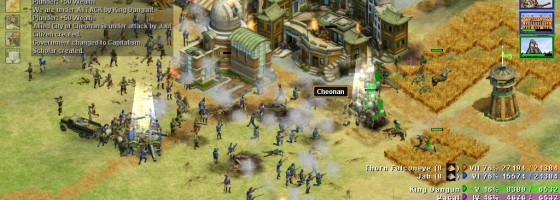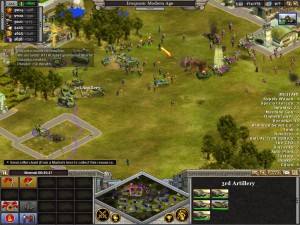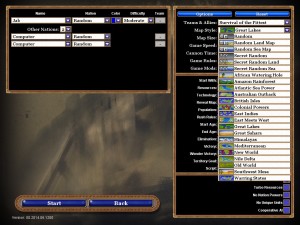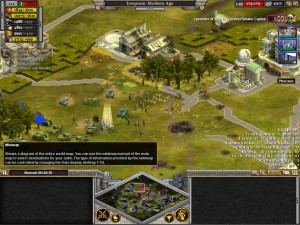Rise of Nations Extended Edition was released recently and marks the return of in my opinion one of the best strategy games ever made. Since the game came out in 2003, we’ve seen a number of major RTS series released. Starcraft 2, Wargame, Supreme Commander and so many more.
Yet when I think about my favorite RTS and the one that did so much right, Rise of Nations takes the crown with mechanics that to this day should have been seen in other strategy games.
Real Time Civilization:
Rise of Nations was created by Big Huge Games and designed by Brian Reynolds who previously worked at Firaxis developing the Civilization games and Alpha Centauri. Keeping with the style of Civilization, the goal on a Rise of Nations map was to take over and the game featured many brilliant ideas that made it like a real time version of Civilization.
You could choose different ages or time periods to start your game at — From the days of fighting with sticks and stones all the way up to modern day with planes, tanks and nukes. What’s important is that just like in Civilization your strategies hinge on not only what age you’re at but your opponents as well.
Speaking of civilizations, you can play as a variety of different civilizations. Each civ has two big differences: unique units and passive bonuses. Instead of making use of the standard version of a unit type, the civs can have unique versions based on their history. So with the British instead of having regular archers at one point, they’ll have enhanced longbow men instead.
This affects the flow of a match as certain civs are better military wise at different ages based on their unique units. The passive bonuses remain constant throughout and are tuned towards defensive, economic or aggressive strategies.
Each time you age up, new resources and units become available. In the early eras you’ll only have to worry about food, gold and wood, but eventually knowledge, metal and oil will need to be gathered.
While there are technically only a few types of infantry, siege units and cavalry in the game, units can be upgraded to more advanced versions as the research becomes available.
This is a big deal as you move into the gunpowder age where units will start using guns and mounted units will eventually be replaced by tanks. Units of an earlier era are weaker against units that are more advanced and you do not want to bring a knight to a tank fight. This also throws the rock paper scissors balance into disarray as earlier age units won’t be able to counter advanced forms of units that they are strong against.
The use of cities and territory to establish areas of control gave the maps a constant sense of change to them. Once you research attrition, enemy units will take damage while they are in your territory unless they bring supply vehicles. While rushing was certainty an option, Rise of Nations use of attrition gave turtling and boom players a defense.
The cities were also used to increase your resources as you could only build a limited number of resource producers per city. This forced you to keep building your nation and at the same time leaving yourself more open to attacks as a small area is easier to defend than a big one.
But once a city has been established with all the resource producers, outside of defense the city becomes completely self reliant. It’s not like Starcraft where you need to micromanage workers to new resources. Instead your cities become your backbone allowing you to fully focus on military efforts and improvements.
This also has the side effect of making Rise of Nations a very macro oriented style which I’ve talked about in the past as something I prefer compared to micro focused games.
The turn based strategy mechanics alone would make Rise of Nations an interesting game, but it is also the first RTS to feature a different type of singleplayer campaign.
Everybody Wants to Rule the World:
Even to this day, most single player campaigns in RTS titles fall into two camps. Either story driven pseudo puzzle levels like Starcraft or generic player vs. AI matches with a loose story to tie it together. What Rise of Nations did was follow in suit of the Total War series by bridging real time and turn based strategy together.
Each scenario sets the player in a different part of the world at a different time and challenges them to take it over.
The different territories on the map will give the player resources that they can make use of in future battles.
When the player invades an enemy territory, the combat plays out like a typical match with restrictions based on the age that the world was set as. This use of a Meta game attached to the battles was innovative at the time and something that very few strategy games try for.
In fact the only two currently on the market that went this route would be the latest expansion to Wargame and the upcoming Planetary Annihilation with the galactic war mode.
The last part that made Rise of Nations a success in my eyes is the most understated element: The UI.
Creative Controls:
A good UI is paramount to any real time strategy game and it requires a combination of unit controls, information displays and hotkeys. I don’t know how long Big Huge Games spent on theirs but what we got was one of the most comprehensive UIs ever. Displays allowed you to see at a glance how many units you had, what researches were available, state of the world and so on without needing to switch screens.
Information was very easy to follow with tool tips for just about everything on screen to let you know what’s going on and how to fix resource issues. Rise of Nations was also the only RTS that comes to mind that fought against the micro management tactic of focus firing on units to kill them quicker. Units would actually receive a damage penalty if they attacked the same unit as opposed to spreading out their attacks.
Unlike Command and Conquer which eventually got more micro focused with multiple unit abilities and special functions, Rise of Nations only featured two specialty units: Generals and Spies.
Spies were used to sneak into enemy cities and gain information while generals provided bonuses to armies and had a few special tricks to use.
The hot key system was one of the most elaborate I’ve seen from the genre allowing players to control buildings and units effortlessly using the keyboard. You can switch between multiple barracks without needing to assign them control groups as well. But the one area where I praise the UI the most is with one simple functionality: Being able to assign rally points directly to control groups.
This alone was a godsend for people like me who suck at high speed micro play. The functionality despite being so useful has not found its way into many RTS games with the only one I can think of currently would be Sins of the Solar Empire. I consider this to be a litmus test for whether or not I’m going to enjoy a strategy game and something that I am hoping and praying will be in Planetary Annihilation.
If I was hard-pressed to point anything that was “wrong” with Rise of Nations, I have just a few nitpicks. First is that the simple graphics does make it hard to pick out units and building types on first glance. And when building and unit designs change with the ages, it can be hard to figure out what is what. This becomes very annoying when you have to either find unit production buildings or trying to decide what units to build to counter the enemy’s.
Rise of Nations features very powerful hotkeys that allow you to manage unit production, research and more without having to swap back and forth between screens. This is very important and a new player who can’t keep track of the hot keys will be in for a world of hurt.
The other problem is that Rise of Nations lacks any kind of “Pop” in the sense of having outrageous moments or strategies. What I mean is that you won’t find anything crazy like dark templar rushes or super units that wipe everyone out.
The most complicated units in the game would be the spy and the general which are still very basic compared to the other strategy games on the market. Rise of Nations was a very methodological strategy game which is very rare for the genre. You do get access to air units and nukes but their use is strictly for the late game and usually the game will be decided before they get called into play.
Incidentally that pop would be seen in the spiritual follow-up Rise of Legends which given the rate these strategy games are resurfacing, we may be playing soon.






